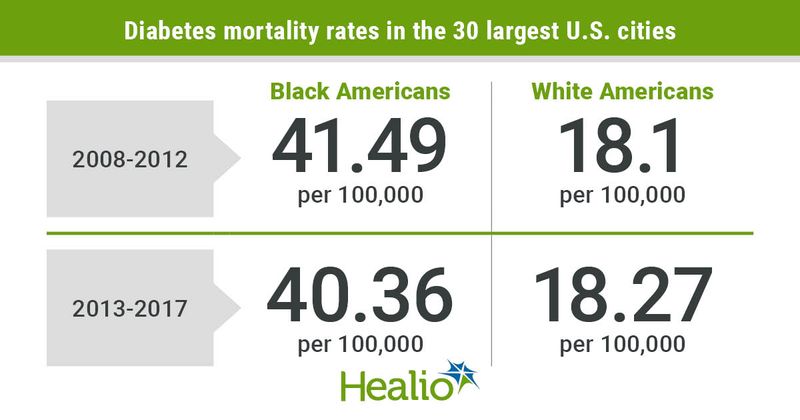Diabetes mortality more than double for Black vs. white adults in large US cities
Diabetes mortality rates in the United States were more than twice as high for Black adults compared with white adults from 2008 to 2017, according to a study published in Diabetes Research and Clinical Practice.

“The main cause of diabetes mortality inequities is likely due to issues of systemic racism and oppression,” Joanna Buscemi, PhD, a clinical psychologist and assistant professor in the department of psychology at DePaul University, told Healio. “The best solutions would be policy actions that cap the cost of insulin and increase access to health care, fruits and vegetables, and opportunities for physical activity. Physicians should advocate for policies such as these to close diabetes and other health inequity gaps.”

Buscemi and colleagues calculated diabetes mortality rates from 2008 to 2017 using data from the National Vital Statistics System multiple cause-of-death data file. Diabetes mortality included any death in which diabetes was listed as the underlying cause. Diabetes mortality rates were calculated for the 30 largest U.S. cities according to U.S. Census Bureau data from 2013. American Community Survey estimates from 2010 and 2015 were used to calculate the white population size, and U.S. Census Bureau data from 2010 and American Community Survey estimates from 2015 were used to calculate the Black population size. Diabetes mortality rates were also calculated for a 5-year period from 2008 to 2012, and another 5-year period from 2013 to 2017.
The diabetes mortality rate in the U.S. increased from 20.91 per 100,000 people from 2008 to 2012 to 21.05 per 100,000 from 2013 to 2017. El Paso, Texas, and Memphis, Tennessee, had the two highest mortality rates during both periods. San Antonio had the third-highest diabetes mortality rate from 2008 to 2012, and Baltimore had the third highest rate from 2013 to 2017. The city with the lowest diabetes mortality rate during both periods was San Francisco.
Racial inequities
The diabetes mortality rate for Black adults was 41.49 per 100,000 people from 2008 to 2012 — 2.29 times higher than the rate for white adults of 18.1 per 100,000. The diabetes mortality rate from 2013 to 2017 decreased to 40.36 per 100,000 for Black adults and increased for white adults to 18.27 per 100,000.
Washington, D.C., had the largest Black-to-white diabetes mortality incidence rate ratio (IRR) from 2008 to 2012 (IRR = 6.15; 95% CI, 4.58-8.25) and 2013 to 2017 (IRR = 6.82; 95% CI, 4.92-9.44), whereas Detroit had the lowest IRR in both 2008 to 2012 (IRR = 1.31; 95% CI, 1.07-1.61) and 2013 to 2017 (IRR = 1.51; 95% CI, 1.2-1.9). Buscemi said it was surprising to see such a large racial disparity in diabetes mortality rates in Washington, D.C.
“In wards 7 and 8 in Washington, D.C., food deserts are prominent, unemployment rates are the highest, and 90% of residents are Black,” Buscemi said. “These neighborhoods are disproportionately impacted by chronic diseases and especially could benefit from wealth-building initiatives, improved access to government programs that increase access to health care and community members to help them navigate their health care and disease management. It would go a long way to improving longevity for Black Americans with diabetes.”
Compared with 2008 to 2012, Chicago, Los Angeles and Oklahoma City had increases in diabetes mortality racial inequities in 2013 to 2017, whereas Louisville, Kentucky, and Phoenix had decreases in inequity. There were 7,365 excess deaths among Black adults each year due to racial inequities in diabetes mortality rates from 2013 to 2017, with New York having the highest number of excess deaths among Black people with diabetes.
“Black patients with diabetes may be at higher risk for mortality from diabetes and may benefit from community health workers, patient navigators or other community resources to help them attend appointments, manage their disease and afford their medications,” Buscemi said.
Best and worst performing cities
Researchers categorized each city into a quadrant based on whether its diabetes mortality rate and racial inequity in diabetes mortality was above or below the national average. Boston, Dallas and Denver were identified as the “best performing” cities with diabetes mortality rates and racial inequities in diabetes mortality both lower than the national average. There were 13 cities described as “worst performing” with diabetes mortality rates and racial inequity higher than the national average: Memphis, Tennessee; San Antonio; Fort Worth, Texas; Oklahoma City; Phoenix; San Jose, California; Portland, Oregon; Jacksonville, Florida; Indianapolis; Houston; Nashville, Tennessee; Las Vegas; and Los Angeles.
“Cities with the highest diabetes mortality inequities should focus funding and intervention efforts on improving equity for Black Americans,” the researchers wrote.
For more information:
Joanna Buscemi, PhD, can be reached at jbuscem2@depaul.edu.

